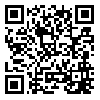Volume 72, Issue 1 (April 2014)
Tehran Univ Med J 2014, 72(1): 52-58 |
Back to browse issues page
Download citation:
BibTeX | RIS | EndNote | Medlars | ProCite | Reference Manager | RefWorks
Send citation to:



BibTeX | RIS | EndNote | Medlars | ProCite | Reference Manager | RefWorks
Send citation to:
Haji-Abdolbaghi M, Rasoolinejad M, Abbasian L, Amir Zargar A, Emadi Koochak H, Moradnejad P, et al . Prevalence of HLA-B*57:01 allele in HIV-infected patients in a university hospital in Tehran. Tehran Univ Med J 2014; 72 (1) :52-58
URL: http://tumj.tums.ac.ir/article-1-5923-en.html
URL: http://tumj.tums.ac.ir/article-1-5923-en.html
Mahboobeh Haji-Abdolbaghi1 
 , Mehrnaz Rasoolinejad1
, Mehrnaz Rasoolinejad1 
 , Laden Abbasian1
, Laden Abbasian1 
 , Aliakbar Amir Zargar2
, Aliakbar Amir Zargar2 
 , Hamid Emadi Koochak1
, Hamid Emadi Koochak1 
 , Pardis Moradnejad *
, Pardis Moradnejad * 
 3, Naseh Mohammadi4
3, Naseh Mohammadi4 
 , Ali Pashae Zanjani1
, Ali Pashae Zanjani1 
 , Saeed Bayanolhagh1
, Saeed Bayanolhagh1 
 , Parisa Sadr Poor1
, Parisa Sadr Poor1 


 , Mehrnaz Rasoolinejad1
, Mehrnaz Rasoolinejad1 
 , Laden Abbasian1
, Laden Abbasian1 
 , Aliakbar Amir Zargar2
, Aliakbar Amir Zargar2 
 , Hamid Emadi Koochak1
, Hamid Emadi Koochak1 
 , Pardis Moradnejad *
, Pardis Moradnejad * 
 3, Naseh Mohammadi4
3, Naseh Mohammadi4 
 , Ali Pashae Zanjani1
, Ali Pashae Zanjani1 
 , Saeed Bayanolhagh1
, Saeed Bayanolhagh1 
 , Parisa Sadr Poor1
, Parisa Sadr Poor1 

1- Iranian Research Center for HIV/AIDS, Iranian Institute for Reduction of High-Risk Behaviors, Tehran University of Medical Sciences, Tehran, Iran.
2- Molecular Immunology Research Center, Medical School, Tehran University of Medical Sciences, Tehran, Iran.
3- Iranian Research Center for HIV/AIDS, Iranian Institute for Reduction of High-Risk Behaviors, Tehran University of Medical Sciences, Tehran, Iran. ,parmorad@gmail.com
4- Department of Vitreous and Retina, Vitreoretinal Consultant, Razi Eye Clinic, Tehran, Iran.
2- Molecular Immunology Research Center, Medical School, Tehran University of Medical Sciences, Tehran, Iran.
3- Iranian Research Center for HIV/AIDS, Iranian Institute for Reduction of High-Risk Behaviors, Tehran University of Medical Sciences, Tehran, Iran. ,
4- Department of Vitreous and Retina, Vitreoretinal Consultant, Razi Eye Clinic, Tehran, Iran.
Abstract: (6250 Views)
Background: Abacavir is an anti-retroviral medication used to treat HIV infected/AIDS patients and its efficacy has been proven in randomized clinical trials. The most significant adverse reaction associated with abacavir is the acute hypersensitivity phenomenon which manifests in many forms and in severe cases could result in death. Hypersensitivity reaction to abacavir has been closely linked to the presence of HLA-B*57:01 allele. Avoidance of abacavir initiation in allele-positive patients is the most effective strategy in preventing possible severe hypersensitivity reactions. Previous epidemiologic studies have made great strides toward delineating HLA-B*57:01 allele frequency in different regions of the World and the available results indicate significant discrepancy between geographical regions. Despite these efforts, no study to date has determined the allele frequency among Iranian HIV-positive patients. The aim of the present study was to determine the proportion of allele-positive patients among a group of Iranian HIV-infected patients.
Methods: Between September 2012 and February 2013, 122 HIV-positive patients were selected among patients referred to Imam Khomeini Hospital’s Consultation cen-ter for high risk behaviors using the convenience sampling method. Sampling scheme was designed in a manner to include equal number of infected patients with and without clinical Acquired Immunodeficiency Syndrome (AIDS). Patient data was collected using available records and a blood sample for DNA analysis was also obtained. Presence of HLA-B*57:01 allele was determined using the Polymerase Chain Reaction- Sequence Specific Method (PCR-SSP).
Results: Seventy three patients (59.8%) were male. Co-infection with hepatitis B and C was observed in 1.7% and 40.7% of the patients, respectively. History of addiction and anti-retroviral therapy was positive in 50.0% and 60.7% of the patients, respectively. Overall, three patients were allele-positive which corresponds to a frequency of 2.46% (95% CI: 0.005-7.30). No association between presence of allele and investigated vari-ables were identified.
Conclusion: Frequency of HLA-B*57:01 allele among a group of Iranian HIV-infected patients is estimated to be 2.5%. This rate is comparable to those reported in other Middle-Eastern countries, yet is relatively lower than reports generated from South-Eastern Asia, Europe, and the United States. Future studies with larger sample sizes are needed to corroborate these findings.
Type of Study: Original Article |
Send email to the article author
| Rights and permissions | |
 |
This work is licensed under a Creative Commons Attribution-NonCommercial 4.0 International License. |



